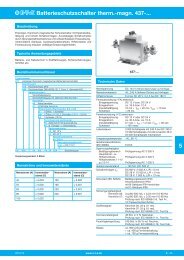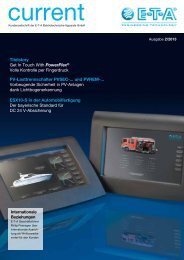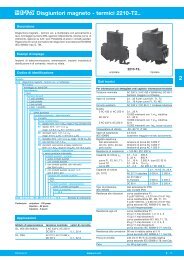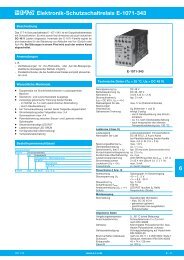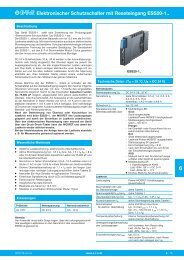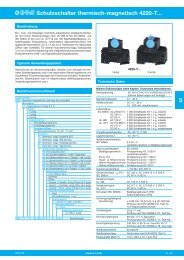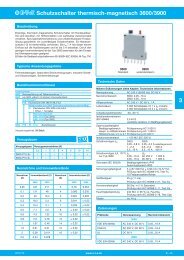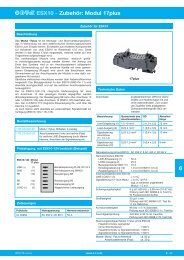Download - ETA
Download - ETA
Download - ETA
Create successful ePaper yourself
Turn your PDF publications into a flip-book with our unique Google optimized e-Paper software.
current<br />
Customer Magazine of E-T-A Elektrotechnische Apparate GmbH Issue 2/2011<br />
Cover Story<br />
A type with many good qualities<br />
Circuit breaker 1620/1626 type 2<br />
goes AC<br />
Distributed bus system<br />
now available for 230 VAC<br />
Safety afloat<br />
in RNLI life-boats<br />
From electric<br />
mobility to<br />
E-T-A mobility<br />
E-T-A Director<br />
Carl Horst Poensgen on<br />
automobile locomotion,<br />
an industry of the future
2<br />
4/5<br />
goes AC<br />
Distributed bus system<br />
now available for 230 V AC<br />
6/7<br />
10<br />
FAQ – Frequently Asked Questions<br />
All you ever wanted to know about<br />
E-T-A products.<br />
14<br />
Contents<br />
A type with many good qualities<br />
Circuit breaker 1620/1626 type 2<br />
Safety afloat<br />
in RNLI life-boats<br />
Editorial 3<br />
goes AC<br />
Distributed bus system<br />
now available for 230 V AC 4/5<br />
A type with many good qualities 6/7<br />
Colour Display with Touch Function<br />
and integral CAN-interface. 8<br />
Personnel 9<br />
FAQ – Frequently Asked Questions 10<br />
Reduce CO 2 emission –<br />
use Smart Power Relay E-1048 11<br />
Applications 12/13<br />
Safety afloat<br />
in RNLI life-boats 14<br />
Englishman‘s favourite:<br />
»Shepherd‘s Pie« 15<br />
Cover photo:<br />
Circuit breaker 1620/1626 type 2.<br />
Further information on pages 6 and 7.<br />
Impressum<br />
Current, Customer Magazine of<br />
E-T-A Elektrotechnische Apparate GmbH<br />
Editor:<br />
E-T-A Elektrotechnische Apparate GmbH<br />
Industriestraße 2-8 . 90518 ALTDORF<br />
GERMANY<br />
Phone: +49 9187 10-0 . Fax +49 9187 10-397<br />
E-Mail: info@e-t-a.de . www.e-t-a.com/e<br />
Responsible:<br />
Thomas Weimann<br />
Layout:<br />
E-T-A Communications Department<br />
Circulation:<br />
16.000 Copies
Electric Mobility turns<br />
into E-T-A Mobility<br />
Editorial<br />
There is hardly any other<br />
topic in environmental<br />
discussions which is<br />
so amply discussed<br />
presently as electric<br />
mobility. Meanwhile<br />
this has even become a<br />
topical subject in politics<br />
where electric mobility<br />
has been identified as<br />
a market of the future<br />
and where this type of<br />
energy is considered as<br />
most important for automobile locomotion.<br />
However, if we start looking at all those<br />
discussions, considerations and concepts<br />
a bit more closely, we will very quickly<br />
discover the uncertainty which is still<br />
connected with this topic. In fact nobody<br />
seems to have reliable<br />
knowledge today about<br />
eventual future technical<br />
developments and<br />
which types of electric<br />
mobility will finally make<br />
the running. Innovation, courage and<br />
foresighted thinking are more in demand<br />
than ever.<br />
As a globally acting medium-size company,<br />
we have been dealing with the subject of<br />
electric mobility for quite a while and we<br />
have clearly identified the requirements<br />
which are relevant for our industrial sector.<br />
What kind of professional<br />
electrical protection<br />
solutions will be required<br />
by electric cars to ensure<br />
reliable function and to<br />
provide suitability for<br />
everyday use? We have<br />
been working on these<br />
questions for quite some<br />
time and we have assigned<br />
adequate resources in<br />
Research and Design. This<br />
will help to turn electric<br />
mobility into E-T-A mobility from the start.<br />
One thing is for sure: no matter which<br />
concept will make the running in the<br />
end – at any rate there will have to be<br />
a suitable protection for these currents.<br />
Switching high d.c. currents will be of the<br />
greatest importance, hence our design<br />
work is focussing on this aspect, whether<br />
it concerns the vehicles themselves or a<br />
reliable network of charging stations.<br />
If you want to learn more about our<br />
concepts or if you require more detailed<br />
information and advice regarding a project<br />
or quotation, please do not hesitate to get<br />
in touch.<br />
Carl Horst Poensgen<br />
Executive Committee<br />
E-T-A Elektrotechnische Apparate GmbH<br />
3
At a glance – AC Module<br />
● 16 channels single pole<br />
with CAN bus control<br />
● max. 30 A per channel<br />
● 75 A total current<br />
● single or double pole<br />
● 120 V AC or 230 V AC
goes AC<br />
Up to now, had been<br />
restricted to 12 and 24V DC electrical<br />
systems. However, some of the electrical<br />
loads on board are supplied with<br />
AC voltage, and as a consequence<br />
was extended to cover<br />
this range as well.<br />
is a power distribution<br />
system that allows monitoring and<br />
controlling electrical loads on boats via<br />
CAN. The CAN bus enables controlling<br />
the electrical system of a boat with one<br />
or even more computers.<br />
Thanks to the new AC module it is<br />
now also possible to switch and protect<br />
AC loads such as the air conditioning<br />
system, the dishwasher or the oven and<br />
protect them at the same time. The AC<br />
module is linked to the rest of the system<br />
via CAN. Inputs or sensors of the DC<br />
system can now also switch and monitor<br />
AC loads.<br />
Of course the special conditions and<br />
requirements of a boat were considered<br />
during the development and design of<br />
the AC module. The AC<br />
voltage can be supplied via shore power,<br />
generator or inverters. Especially larger<br />
yachts or recreational craft do not always<br />
travel in the same region of the world.<br />
Therefore it must also be possible to<br />
connect a 2 phase grid with 120V.<br />
The AC module provides<br />
16 single pole switched and protected<br />
channels, which can be combined to<br />
be 8 double pole channels if required.<br />
The circuit breakers used for protection<br />
are plug-in types. They allow optimum<br />
configuration of the current ratings and<br />
Products<br />
The CAN-controlled Power Distribution System<br />
PowerPlex is now also available for 230V AC.<br />
The new PowerPlex AC module allows switching and protection of numerous AC loads at the same time<br />
the use of double pole breakers. The<br />
maximum total current is 75 A, with the<br />
maximum current per channel being 30 A.<br />
In order to be widely independent of<br />
the available voltage without draining<br />
the batteries of the DC system, the AC<br />
module is fitted with its own AC power<br />
supply.<br />
Through launching the AC<br />
module it has now become possible to<br />
control definitely all electrical loads on<br />
board of a boat via – without<br />
exceptions.<br />
5
At a glance – features and benefits of type 1620-2:<br />
● no replacement fuses required, can be used instead of fuses<br />
● clear colour coding of current rating<br />
● miniaturised design – fits into MINI fuse blocks<br />
● enhanced reliability for a professional environment
In 2010 E-T-A already launched series<br />
1620 (holding 100 percent rated current<br />
continuously in accordance with SAE<br />
J533) and series 1626 (faster trip curve,<br />
holding 70 percent rated current). They<br />
represent an innovative new circuit<br />
breaker type suitable for use in passenger<br />
cars and commercial vehicles. At that<br />
time the product range was limited to two<br />
versions:<br />
● type 1 (12 VDC – automatic reset) and<br />
● type 3 (manual reset – 12 and 24 VDC).<br />
In March 2011 this programme has been<br />
extended by the so-called type 2 (12 VDC).<br />
A circuit breaker SAE type 2 offers the<br />
feature of “modified reset”. This means<br />
the contacts of circuit breaker type<br />
1620-2 will remain open after tripping in<br />
the event of overload or short circuit as<br />
long as power is applied to the terminals.<br />
Only upon switching off the ignition or<br />
the load in question will the breaker be<br />
reset automatically. Technical realisation<br />
of the modified reset feature is by means<br />
of a heating element through which a<br />
minimum limited residual current will flow.<br />
It is a highly interesting fact that type<br />
1620-2 requires only one third of the<br />
holding current required by other models<br />
available in the market.<br />
Ever since our product launch we have<br />
experienced brisk interest from OEMs or<br />
tier 1 suppliers in the automotive industry<br />
and a substantial demand for such a protection<br />
concept. Type 1620-2 is available<br />
in seven ratings from 5 to 30 A. The<br />
current rating is marked on the device<br />
Cover Story<br />
The new circuit breaker raises the bar as it is the only<br />
circuit breaker in the market which really and reliably<br />
works as a type 2 version.<br />
Circuit breaker 1620/1626 type 2 for passenger cars and commercial vehicles<br />
A type with<br />
many good qualities<br />
and the moulded housing is coloured<br />
correspondingly as specified in DIN/ISO<br />
standards. This allows quick and easy<br />
replacement of fuses or circuit breakers<br />
made by other manufacturers.<br />
Typical loads to be protected by type<br />
1620-2 include<br />
● seat adjustment motors<br />
● windshield wipers<br />
● power outlets in the vehicle (more and<br />
more important in view of the growing<br />
number of possible applications)<br />
● electric sunroofs<br />
● power outlets for trailers<br />
● all loads which often cause fuses to<br />
blow<br />
Summary: for all these<br />
applications the circuit<br />
breaker significantly<br />
increases reliability and<br />
safety of a passenger car<br />
or truck.<br />
What’s so special about<br />
circuit breaker 1620<br />
type 2?<br />
● production on a fully<br />
automatic assembly line<br />
with multiple test steps, leading to<br />
100 % quality – each E-T-A circuit<br />
breaker will only leave the factory after<br />
having been tested!<br />
● an innovative heating element which<br />
reduces housing and terminal temperature<br />
after tripping (unlike competitive<br />
devices)<br />
● suitability for high ambient temperatures<br />
up to 105 °C<br />
● moulded housing with clear colour<br />
coding related to current ratings<br />
● low holding current – increasing life<br />
span of the battery and reducing C0 2<br />
emission<br />
● space-saving design – suitable for fuse<br />
blocks and central electric boxes for<br />
MINI fuses.<br />
E-T-A is setting the pace for circuit<br />
protection!<br />
High-quality reliability<br />
for cars: E-T-A circuit<br />
breaker 1620/1626<br />
type 2<br />
7
Colour Display with Touch Function<br />
and integral CAN-interface.<br />
Graham Lewis,<br />
Business Development<br />
Manager at E-T-A UK<br />
E-T-A UK is active<br />
in many business<br />
fields. One<br />
important market<br />
for E-T-A UK is the<br />
marine industry.<br />
Graham Lewis<br />
is the Business<br />
Development<br />
Manager for this<br />
market segment.<br />
He is supporting<br />
boat builders with<br />
information about E-T-A’s PowerPlex<br />
System and concepts for modern<br />
computerized electrical systems. Graham<br />
is involved in the development of new<br />
components for the System<br />
and is one of the main pacemakers for<br />
innovation in our product range.<br />
Current: What are the main criteria for<br />
the selection and development of new<br />
user interfaces?<br />
Graham Lewis: The most important<br />
reason for new user interfaces are<br />
definitely the requirements and<br />
wishes of our lead customers in the<br />
different market segments. We have to<br />
distinguish between two main branches<br />
in the marine industry – workboats and<br />
leisure yachts.<br />
Current: Where do you see differences<br />
or synergies between the two market<br />
segments?<br />
Graham Lewis: Both sectors are definitely<br />
asking for high quality products, especially<br />
designed for their application with a<br />
maximum of flexibility. Another important<br />
factor is the service for our products<br />
that should be available in every part of<br />
the world. The differences are mainly on<br />
the design side. On a workboat clear<br />
information needs to be provided and the<br />
handling has to be easy – a nice design is<br />
8<br />
Interview<br />
In addition to touch function and CAN interface, the PowerPlex system offers tailor-made layouts for boatbuilders.<br />
good but not the main focus. Whereas on<br />
a leisure boat the main focus is comfort<br />
and high quality design combined with a<br />
modern style.<br />
Current: How can you manage to<br />
provide both, modern style and a<br />
clear structured design to satisfy both<br />
markets?<br />
Graham Lewis: This is definitely not<br />
easy, but the flexibility of our CAN system<br />
allows us to use standard<br />
products for the system’s backend<br />
and customized user interfaces for the<br />
front-end. The modules<br />
are identical for both markets, but the<br />
layout of the user interface is different<br />
regarding functionality and design.<br />
Current: What is the main benefit of<br />
using a touch screen like the new 4.3”<br />
colour display?<br />
Graham Lewis: It provides a maximum<br />
of flexibility in the design of the GUI<br />
and regarding the functions provided.<br />
We are able to supply tailor made<br />
designs for different OEMs and even<br />
for different types of boats. The main<br />
benefit compared to a key pad is the<br />
possibility to display text messages<br />
provided via pop ups for alarm or status<br />
messages. It is a big improvement in<br />
usability when you get instructions<br />
instead of a blinking red light.<br />
Current: Thank you for your time.
Royce Rote<br />
Business Development<br />
Manager<br />
– Transportation<br />
Royce Rote<br />
joined E-T-A US<br />
in September<br />
2006 and brought<br />
with him years<br />
of experience specifically in the area of<br />
aerospace, defense and transportation. In<br />
Brett Macdonald<br />
Business Development<br />
Manager<br />
–<br />
Brett Macdonald<br />
joined the E-T-A<br />
US Sales &<br />
Business development<br />
team in<br />
July 2010. Before<br />
joining E-T-A, Brett spent six years<br />
Graham Lewis<br />
Sales Engineer for<br />
Marine and Telecommunications<br />
We were very<br />
pleased to welcome<br />
Graham at E-T-A<br />
UK earlier this year.<br />
Graham has joined<br />
us with a wealth of experience in the<br />
electrical and electronic fields.<br />
Personnel<br />
his role at E-T-A, Royce is responsible for<br />
all areas within the transportation market<br />
including: passenger cars, commercial<br />
and agricultural equipment, rail vehicles,<br />
buses, military vehicles, commercial and<br />
defense based aircraft and custom system<br />
solution designs.<br />
Royce works directly with Marko Wilsdorf<br />
and the US based regional sales managers<br />
to expand E-T-A’s reach into the market.<br />
managing the Wes-Garde Components<br />
multiplexing efforts, including the E-Plex<br />
line.<br />
This experience gave Brett a wealth of<br />
knowledge in multiplexing technology<br />
and what is currently available and being<br />
used in the market. Brett works closely<br />
Fred Zöls and the US regional sales<br />
managers in areas where boat building<br />
and caravan manufacturing exists to<br />
His work involvement has also extended<br />
to specialised network applications in the<br />
marine market, including J1939 and NMEA<br />
2000 systems.<br />
Among Graham’s diverse roles he will be<br />
promoting the benefits of our<br />
system to marine customers.<br />
We have developed to meet<br />
the special electrical circuit requirements of<br />
Royce also manages the introduction of<br />
new products into the market – most<br />
recently the launch of the 1620/1626 and<br />
the PR60 & PR80. Royce’s knowledge<br />
of the market, creativity in presenting<br />
products and strong connection to the<br />
sales team has brought the transportation<br />
division in the US to where it is today.<br />
expand the product line into<br />
new accounts.<br />
Brett’s technical understand of the<br />
product allows him to communicate in<br />
the market as an expert. This, along with<br />
the quality of the product, is allowing the<br />
PowerPlex to make inroads into more<br />
leisure yachts, workboats and recreational<br />
vehicles than ever before.<br />
watercraft. It significantly reduces the need<br />
for conventional wiring, combining reliability<br />
and user convenience with easy-to-install<br />
modules. Graham will use his experience<br />
to work alongside potential customers for<br />
this product.<br />
Graham is qualified for electrical installations<br />
to the 17th Edition of the IEE Wiring<br />
Regulations (BS7671) and has received<br />
training at the Lloyds Maritime Academy.<br />
9
Higher<br />
d.c. voltages<br />
Switching high power at direct voltage –<br />
what are the challenges? What are the<br />
chances?<br />
Presently high d.c. voltages are<br />
being discussed in various places of<br />
technology and engineering. This does<br />
not only concern photovoltaic systems<br />
and electric cars, but also d.c. power<br />
grids for power distribution in industrial<br />
buildings. A working group in the IEC<br />
TC23 is dealing with this topic and a EU<br />
research project ENIAC shall be started.<br />
E-T-A is part of both projects.<br />
What will change on the closed contact<br />
at higher d.c. voltages?<br />
The resistance of a closed contact<br />
basically depends only on the contact<br />
force, the specific resistance and the<br />
hardness of the contact material. The<br />
power processed by the contact will then<br />
exclusively be determined by the current<br />
going over it. Hence it will be of no<br />
importance what voltage will be supplied<br />
by the supplying energy source.<br />
What is physically happening when<br />
high d.c. voltages are disconnected?<br />
If the contact opens, the conditions<br />
will change abruptly. There will be a<br />
switch arc which is indeed related to the<br />
driving voltage. This so-called plasma,<br />
a very hot gas consisting of ionised air,<br />
metal ions and electrons, will develop a<br />
certain momentum and has itself to be<br />
considered a voltage source in the circuit.<br />
The arc will only go out if the voltage it<br />
10<br />
is producing is higher than the source<br />
voltage in the circuit. So the higher the<br />
source voltage, the harder can the arc be<br />
quenched.<br />
Is it reasonable to disconnect as<br />
quickly as possible?<br />
If we disconnected an inductive circuit<br />
within an infinitely short period of time,<br />
the energy stored in the circuit would be<br />
unloaded through explosions. A switch<br />
arc kills off this energy, but the plasma<br />
life span has to be limited to a few<br />
milliseconds to keep thermal effects at<br />
bay. This will be done by additional<br />
energy removal by means of quenching<br />
sheets, outgassing chamber walls or arc<br />
extension through magnetic fields.<br />
Wouldn’t it be easier to disconnect<br />
electronically?<br />
The advantage of electronic power<br />
semi-conductors in a switching process<br />
compared to mechanical contacts is<br />
their controllability. In addition there will<br />
be no arc. The resistance of the open<br />
contact clearance can be changed in a<br />
defined time from low-resistance to highresistance.<br />
However, semi-conductors<br />
withstanding higher voltages in the OFF<br />
condition are still very expensive so that<br />
economic considerations often override<br />
technical possibilities.<br />
What are the d.c. voltages in question?<br />
For photovoltaic applications, voltages<br />
up to 800 VDC have become usual<br />
today, values up to even 1,500 VDC are<br />
being discussed. For electric mobility<br />
we are talking about values of 350 to<br />
600 VDC, for commercial vehicles even<br />
900 VDC are being discussed. Fuel cells<br />
might become the batteries of the future<br />
Our FAQ pages are meant to intensify the dialogue between<br />
manufacturer and customers. They will deal with topics arising<br />
from practice and answer relevant questions as shortly as<br />
possible and as detailed as necessary.<br />
Do you have any questions you need answer to?<br />
Send it to us – we are looking forward to hearing from you.<br />
E-T-A Elektrotechnische Apparate GmbH<br />
Keyword: Current FAQ<br />
Industriestraße 2-8, 90518 Altdorf<br />
E-Mail: faq@e-t-a.de<br />
and are suitable for all aforementioned<br />
voltages. Buildings will be equipped with<br />
regenerative systems supplying direct<br />
voltage. Therefore some experts also<br />
speculate about 380 VDC as a mains<br />
supply voltage in buildings.<br />
What is the wattage range in question?<br />
In photovoltaic systems the wattage<br />
range is from only a few kW up to several<br />
MW in solar power plants. Usual wattage<br />
for electric cars today is 40 to 60 kW. For<br />
building wiring installtion it will most likely<br />
be a few kW.<br />
What technologies are already available<br />
to switch off high d.c. voltages?<br />
Technologically we can use either purely<br />
mechanical solutions as well as electronic<br />
solutions. In addition hybrid devices seem<br />
to be very promising as they combine the<br />
advantages of both approaches.<br />
What are the chances for E-T-A?<br />
Besides opportunities in photovoltaic<br />
systems there will be new business<br />
opportunities also in the automotive<br />
industry for electric cars and on the score<br />
of HVDC networks for building installation,<br />
for data centres and telecommunications<br />
equipment.
Reliable switching<br />
of loads is the<br />
major task of a<br />
relay. Additional<br />
reasons for using<br />
electronic relays<br />
are their enhanced<br />
shock and vibration<br />
Marko Wilsdorf, Business resistance, their<br />
Field Manager and Head insusceptibility to<br />
of the Transportation<br />
dust and dirt, their<br />
Division of E-T-A<br />
noiseless operation<br />
as well as their<br />
suitability to include additional functions<br />
and benefits (e.g. overcurrent protection,<br />
delayed trip behaviour, bus connection…)<br />
In view of all this you may not think of<br />
fuel consumption and reduction of CO 2<br />
emissions in the first place when talking<br />
about semi-conductor relays or solid state<br />
remote power controllers.<br />
However, with Diesel prices skyrocketing,<br />
all components of a car are being put to<br />
the test whether they could in some way<br />
help to save fuel.<br />
In this respect, semi-conductor relays<br />
such as type E-1048 can score again,<br />
because a standard electro-magnetic<br />
relay (EMR) up to a current rating of 50A<br />
requires a permanent holding current of<br />
typically 130 mA, whereas the electronic<br />
relay only requires a control current<br />
of typically 5 mA. In a 24 V electrical<br />
on-board system of a commercial vehicle<br />
this means savings of up to 3 W per relay.<br />
This may not sound much, but considering<br />
the efficiency of the diesel engine and the<br />
generator (see fig. 1) this turns into more<br />
than 30 l Diesel fuel and thus more than<br />
80 kg CO 2 emissions which are saved per<br />
vehicle and year (see table 1).<br />
Good Practice<br />
Reduce CO2 emission –<br />
use Smart Power Relay E-1048<br />
A semi-conductor relay helps to save fuel: Smart Power Relay E-1048-8D<br />
Values for 10 relays in vehicle Fuel savings (diesel) 1 CO2 reduction 2<br />
per hour 0,015 l 40 g<br />
per hour (8 working hours/day) 0,122 l 321 g<br />
per year (250 working days/year) 30,612 l 80,204 g<br />
1 heating value of diesel: 9.8 kWh/m³<br />
2 CO2 emission per litre diesel: 2,620 g<br />
Savings can also be achieved<br />
with a bistable EMR, but on the<br />
one hand a mono-stable relay<br />
cannot easily be replaced by a<br />
bistable one and on the other<br />
hand many automotive systems<br />
only accept mono-stable<br />
solutions for safety reasons.<br />
Another possibility to save<br />
holding power is to reduce<br />
the current after a switching<br />
operation to the so-called holding<br />
current. This leads to a rarely<br />
acceptable higher susceptibility<br />
to shock and vibration.<br />
Table 1: fuel and CO2 savings<br />
�generator = 50 %<br />
�gene erator<br />
�� diesel engine engine = 40 % diesel die engine<br />
generator<br />
�total = �generator x �diesel engine = 20 %<br />
Pdiss. 3 Watt<br />
Pfed = = ���������= 15 Watt<br />
�total<br />
0,2<br />
Fig. 1: multiplication of energy demand through<br />
poor efficiency<br />
11
E-T-A solutions<br />
for many products<br />
Application: Mobile fuel cells – power<br />
supply<br />
E-T-A Type: 8345 with remote actuation<br />
X8345-R<br />
The SFC Energy AG (www.sfc.com) is the<br />
market leader for mobile and remote power<br />
supplies based on fuel cell technology,<br />
selling more than 20,000 fuel cells per<br />
year. They design and sell power supply<br />
solutions for on-board electrical systems<br />
in special vehicles and public authority<br />
vehicles.<br />
The system shown below consists of an<br />
EFOY Pro fuel cell, a modern lithium battery<br />
and a power inverter, each included in<br />
an easily removable module. The 125 A<br />
circuit breaker type 8345 is fitted in the<br />
battery module for controlled switching<br />
the connected loads on and off.<br />
SFC’s intelligent loading status<br />
monitoring system is measuring<br />
the load of the fuel cell and the<br />
battery. In the event of an overload<br />
at the fuel cell or imminent total<br />
discharge of the lithium battery,<br />
the electrical system will reliably<br />
be disconnected from the fuel cell<br />
system by the 8345 circuit breaker.<br />
Applications<br />
E-T-A offers tailor-made solutions for a<br />
wide range of industries and products.<br />
Here are some interesting examples.<br />
Application: Laser marking equipment<br />
E-T-A Type: 3140<br />
Alltec GmbH (Foba laser marking +<br />
engraving), located in Selmsdorf near<br />
Luebeck, is a major manufacturer of<br />
precision systems for laser marking and<br />
engraving. The laser marker DP30FGS<br />
has been newly included into their<br />
product range and has been<br />
designed particularly for<br />
safety-relevant marking<br />
applications in the ID<br />
and personalisation<br />
sector. This high-tech<br />
laser marker is used for<br />
forgery-proof marking of chip<br />
cards and credit cards as<br />
well as passports, ID cards and driving<br />
licenses. Overcurrent protection is<br />
provided by our three-pole thermal circuit<br />
breaker type 3140 which at the same time<br />
serves as ON/OFF switch of the laser<br />
marker. Its positively trip-free<br />
mechanism allows reliable<br />
switching and ensures<br />
unobstructed operation of<br />
the marking equipment.
Application: Monitoring systems for<br />
photovoltaic power plants<br />
E-T-A Type: ESX10-T<br />
The company skytron@energy, located in<br />
Berlin-Adlershof, is a major manufacturer<br />
of complete monitoring systems for<br />
photovoltaic power plants in the range of<br />
1000 mW. Their product range includes<br />
DC distribution boxes with phase<br />
current measurement by means of data<br />
loggers and servers as well as<br />
high-performance control room<br />
software for plant managers.<br />
In their data logger skylog<br />
skytron uses our electronic<br />
circuit protector ESX10-T<br />
for the selective protection<br />
of the DC 24 V load circuits<br />
Applications<br />
(industrial PCs, ethernet switches, master<br />
pcbs etc.). Selective protection means:<br />
the ESX10-T only disconnects the faulty<br />
path in the event of an overload or short<br />
circuit in the load circuit without any<br />
repercussions on the Dc 24 V supply.<br />
skytron@ energy opted for the version<br />
ESX10-TB-114 with status output<br />
for a fast fault detection and<br />
remote control signal ON/OFF.<br />
Application: Service trains<br />
E-T-A Type: PR60<br />
P.T. INKA (Indonesian Railway Industry),<br />
the state-owned manufacturer of<br />
Indonesian rolling stock, was founded<br />
in 1981 and meanwhile has nearly 1000<br />
people on the payroll. Production facilities<br />
are located in Madiun (Central Java),<br />
they manufacture passenger trains, freight<br />
trains, ambulance trains and also service<br />
trains. Their trains are mainly sold into<br />
the Indonesian market, but also into<br />
neighbouring Asian countries.<br />
P.T. INKA opted to utilize our PR60 for their<br />
new series of maintenance locomotives to<br />
ensure reliable switching of high loads.<br />
They decided to use PR 60 due to its<br />
competitive price/performance ratio,<br />
its compact size and its unrivalled<br />
technical performance. On<br />
grounds of positive experience<br />
they already plan to use the<br />
PR60 in other products such<br />
as their new commuter train<br />
series.
Safety afloat<br />
in RNLI life-boats<br />
Start of series production of the new<br />
class of life-boats for rescue and<br />
transportation of castaways will be end<br />
of 2011. will not only protect<br />
the electrical system, but also control<br />
and monitor electrical loads.<br />
E-T-A is a comprehensive<br />
de-centralised power distribution system<br />
designed to protect, control and monitor<br />
electrical on-board systems in recreational<br />
craft and workboats.<br />
consists of modules<br />
positioned as needed around the vessel.<br />
Each power module is capable of<br />
switching up to 102A continuously and<br />
transferring to 12 outputs. In addition<br />
there are inputs for switches and sensors.<br />
The system functions as a<br />
single programmable control system, with<br />
modules communicating with each other<br />
via a thin wired CAN bus network.<br />
If required, the addition of a touch PC<br />
screen and E-T-A touch PC software<br />
facilitates the full function of the system<br />
from load switching and monitoring to<br />
displaying sensor and alarm information.<br />
Using the Windows based E-T-A software,<br />
the system can be configured to the boat<br />
builder / owner’s requirements.<br />
offers a wealth of new<br />
possibilities, both for the control of on-board<br />
electrical systems and to provide added<br />
functionality to the user. It can perform<br />
additional functions which would otherwise<br />
require costly and complex electronic<br />
solutions.<br />
The system employs a four<br />
level protection concept to ensure utmost<br />
safety at sea. Software and hardware<br />
monitoring of the load current and internal<br />
processor provides effective over-current<br />
protection. In the event of a catastrophic<br />
failure of any output the circuit breaker<br />
can be unplugged and plugged into an<br />
14<br />
International<br />
Protecting, controlling and monitoring with a distributed bus system.<br />
Distributed bus system PowerPlex fitted into life-boats of the RNLI, UK.<br />
additional slot directly connected to the<br />
supply, thus creating a “get home” scenario.<br />
Rugged deployment<br />
Eight modules control<br />
most of the electrical power distribution<br />
on the initial prototype of the latest class<br />
of all-weather lifeboat being developed<br />
by the Royal National Lifeboat Institution<br />
(RNLI). The Fast Carriage Boat 2 (FCB2)<br />
will eventually replace the Mersey class of<br />
lifeboat. After a 3-year test phase production<br />
of the new boat class will start end of<br />
2011. will be connected<br />
to the CAN bus via the SIMS (System<br />
Integrated Management System) and will<br />
be controlled by the shipboard computer.<br />
As the is a Multi-Master-<br />
System, it is fully functional even without<br />
the shipboard computer. Robust keyboards<br />
with CAN bus interface will be used for<br />
controlling functions such as windshield<br />
wipers or illumination.<br />
On completion, the whole fleet of all-weather<br />
lifeboats will have a 25-knot capability, with<br />
the result that casualties can be reached<br />
more quickly and efficiently.<br />
E-T-A PowerPlex-System
Englishman‘s favourite:<br />
»Shepherd’s Pie«<br />
One of the quickest and easiest supper<br />
dishes is a recipe shepherds pie. As<br />
you can see with this easy Shepherds<br />
Pie recipe, traditionally the pie is made<br />
with ground lamb, but if using ground<br />
beef it would be called a Cottage Pie.<br />
However, the recipe is the same for<br />
both.<br />
● Heat the oven to 375 °F/190 °C/Gas 5<br />
● Boil the potatoes until soft then drain<br />
into a colander. Place the milk and<br />
butter in the pan used to boil the<br />
potatoes, return to the heat and warm<br />
gently until the butter has melted. Add<br />
the potatoes and mash. Season to<br />
taste and keep to one side.<br />
● Melt the lard or dripping in a large<br />
deep pan. Add the onion and carrot<br />
and fry for 5 minutes. Add the garlic<br />
and cook for another minute.<br />
● Add the ground lamb and one-third of<br />
the beef stock to the onion and carrot<br />
mixture and cook, stirring constantly<br />
until all the meat is browned. Add<br />
the remaining stock, parsley and<br />
mushrooms, season with salt and<br />
pepper. Cover with a lid and cook for<br />
15 minutes.<br />
Culinary delights<br />
Quick and easy preparation: »Shepherd’s Pie«, traditionally British<br />
● Mash the flour into the remaining 1<br />
tbsp butter then add in small pieces to<br />
the ground meat sauce, stirring until all<br />
the flour has dissolved and the sauce<br />
has thickened slightly, approx 5 mins.<br />
● Place the meat sauce into an 8“ x 3“/<br />
20 cm x 7 cm deep ceramic of glass<br />
ovenproof dish and cover with the<br />
mashed potato. Sprinkle the grated<br />
cheese on top of the potato and bake<br />
in the heated oven for 30 - 35 mins<br />
until the surface is crisp and browned.<br />
Serve immediately.<br />
Prep time: 30 minutes<br />
Cook Time: 40 minutes<br />
Total Time: 1 hour, 10 minutes<br />
Ingredients<br />
● 2 lb / 900g potatoes, peeled and<br />
quartered<br />
● 6 tbsp milk<br />
● 1 stick / 110g butter, cubed + 1 tbsp<br />
for the sauce<br />
● Salt and ground black pepper<br />
● 1/2 tbsp lard or dripping<br />
● 1 cup/ 115g chopped onion<br />
● 1 cup / 115g finely diced carrot<br />
● 1 clove garlic, minced<br />
● 2 cups / 450g ground/ minced lamb<br />
● 1 pint / 600 ml beef stock<br />
● 1 cup / 115g chopped white<br />
mushrooms<br />
● 2 tbsp finely chopped flat leaf parsley<br />
● 1 tbsp all-purpose flour<br />
● 1 cup/ 115g grated Cheddar Cheese<br />
15



